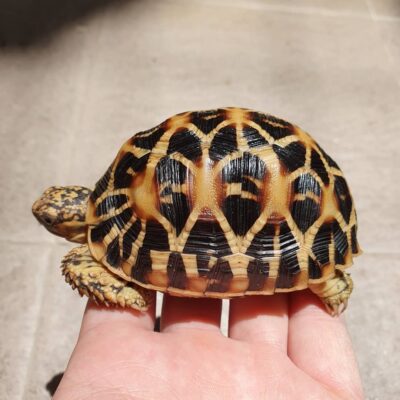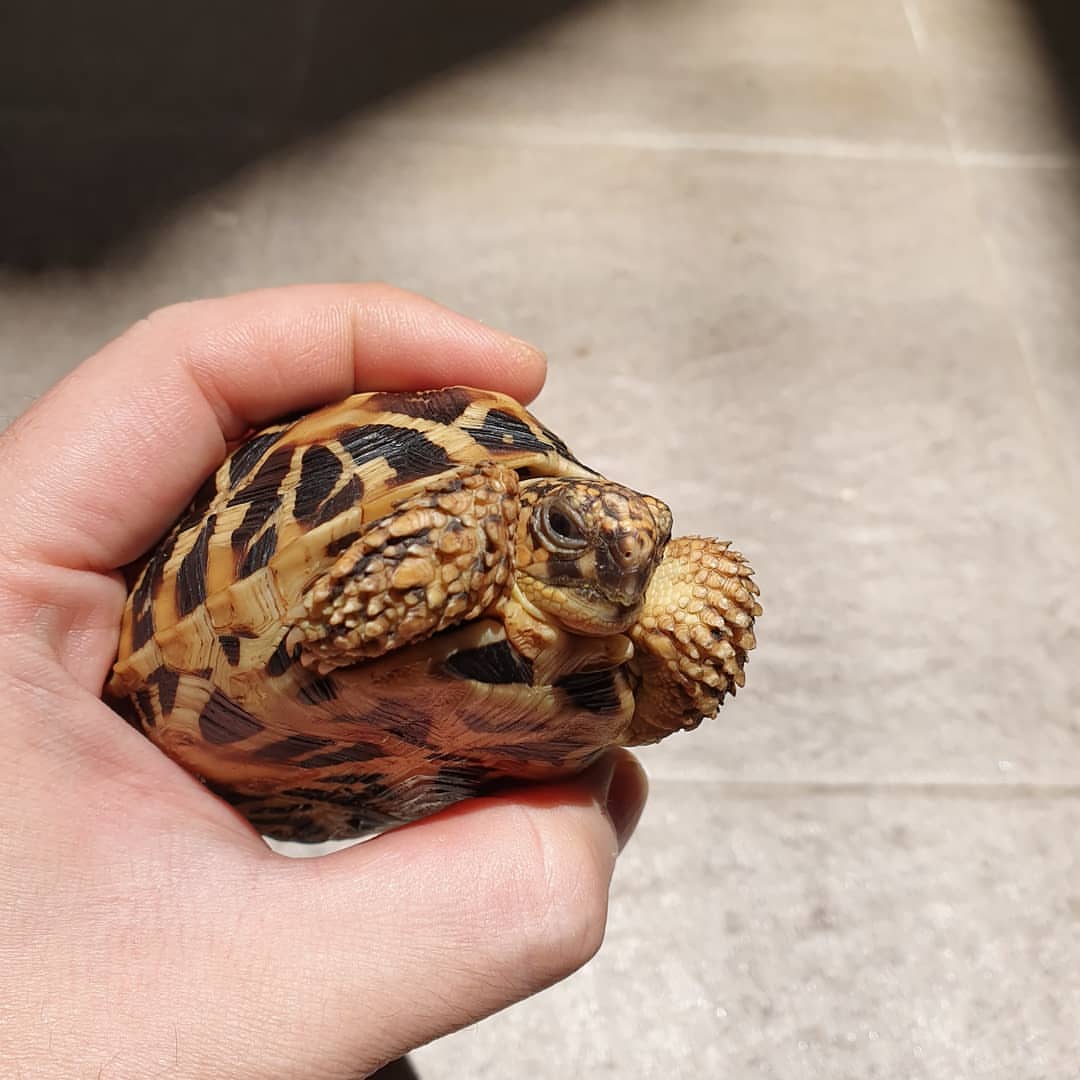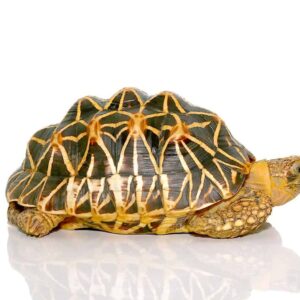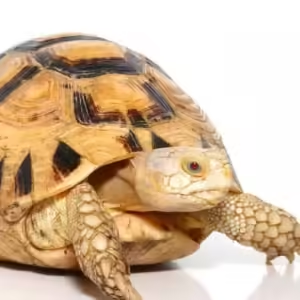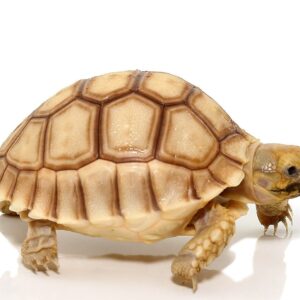Indian Star Tortoise For Sale
$265.00
Indian Star Tortoise
It is believed that the Indian star tortoise (Geochelone elegans ) is threatened species of tortoise that is native in India, Pakistan and Sri Lanka in which it is found in areas of dry land and scrub forests.
It has been classified as vulnerable to the IUCN Red List since 2016 because the population is believed to be greater than 10,000 individuals, however with a decreasing trend. The endangered species is at risk due to the loss of habitat and poaching to facilitate the illegal trade in wildlife.
The status was elevated into CITES Appendix I the year 2019 with full agreement among all member states, providing the highest level of protection against commercial trade. Conservation group TRAFFIC discovered that 6,040 animals were confiscated across the globe, with the intention to be sold through the trade in pet products.
Diet and nutrition
Indian star tortoises mostly herbivores (folivores and frugivores) and mainly consume leaves, grasses fruit, flowers and occasionally insects, carrion, as well as dung.
DIET Herbivore, Folivore, Frugivore
Habits and Lifestyle
Indian star tortoises are typically crepuscular. That means they are active during the early morning hours and in the late afternoon in hot, dry conditions. In the rest times, they hide under the shade of vegetation or other shelter.
In the season of rain they become busier, moving about and eating for the majority of the time. They are inactive when they are in western India and Pakistan in the winter times of winter.
The animals that are solitary are not hibernating but when it’s extremely hot and dry, or extremely cold, they remain at a standstill.
Perception and communication is believed as mostly visual but olfactory and tactile senses are also employed in courtship, feeding and male competitive behavior and nesting. A male tortoise may communicate with females when mating.
GROUP NAME
bale, nest, turn, dole, creep
LIFESTYLE
Terrestrial, Precocial, Grazing, Torpor, Zoochory,
SEASONAL BEHAVIOR
Not a migrant, Hibernating
Description
The Indian Star Tortoise, scientifically known as Geochelone elegans, is a remarkable species that captivates the interest of herpetologists and nature enthusiasts alike. Distinguished by its unique star-patterned shell, this tortoise is easily recognizable and widely admired for its aesthetic appeal. The star-pattern, characterized by radiating yellow lines from the center of each scute, serves not only as camouflage but also as a key identifier of the species.
Native to the Indian subcontinent, the Indian Star Tortoise inhabits a variety of environments, including dry areas, scrub forests, and grasslands. Its geographical distribution spans across India, Pakistan, and Sri Lanka. This adaptability to diverse habitats underscores its resilience, although the species tends to favor regions with a moderate climate, avoiding extreme temperatures.
In its natural habitat, the Indian Star Tortoise plays a significant role in the ecosystem. As a primarily herbivorous animal, it contributes to the control of vegetation and the dispersal of seeds, promoting plant diversity and health. This ecological function is crucial, as it aids in maintaining the balance within its environment, ensuring the sustainability of various plant species.
The conservation of the Indian Star Tortoise is of paramount importance due to its ecological role and the pressures it faces from habitat loss and illegal trade. Recognizing its significance within its native ecosystems, conservation efforts are being implemented to protect this species. These endeavors not only aim to preserve the tortoise itself but also the broader environmental health of the regions it inhabits.
Understanding the intrinsic value of the Indian Star Tortoise can inspire and inform conservation strategies, fostering a collaborative effort to secure the future of this extraordinary species. The fascination with its unique appearance and ecological contribution underscores the need for continued research and protection measures.
Physical Characteristics and Identification
The Indian Star Tortoise (Geochelone elegans) is renowned for its visually striking and unique physical characteristics. One of the most distinguishing features of this species is its star-patterned shell. Each scute on the tortoise’s carapace exhibits yellow or orange radiating lines, creating a star-like pattern against a dark brown or black background. This intricate design not only contributes to its aesthetic appeal but also aids in camouflage within its natural habitat of dry grasslands and scrub forests.
In terms of size, the Indian Star Tortoise exhibits sexual dimorphism, where females are generally larger than males. Adult females can reach up to 15 inches in length and weigh around 6 kilograms, whereas males typically grow up to 10 inches and weigh approximately 4 kilograms. Despite their relatively modest size compared to other tortoise species, their distinctive shell pattern makes them easily identifiable.
Another notable physical characteristic is the tortoise’s high-domed carapace, which is more pronounced than in many other tortoise species. This domed shape, combined with their star-patterned shell, provides a significant advantage in their natural habitat by making it difficult for predators to grasp them. Additionally, the plastron, or the underside of the shell, is flat in females and concave in males, facilitating mating.
To differentiate the Indian Star Tortoise from other tortoise species, one should look for the unique star patterns on the shell, which are absent in species like the African Spurred Tortoise or the Russian Tortoise. Moreover, the Indian Star Tortoise’s limbs are covered with large, overlapping scales, and their head is proportionately small with a pointed snout.
Understanding these physical characteristics is crucial for proper identification and appreciation of the Indian Star Tortoise. Their distinctive features not only highlight their evolutionary adaptations but also underscore the importance of their conservation.
Habitat and Distribution
The Indian Star Tortoise is primarily found in the diverse landscapes of India, Pakistan, and Sri Lanka. These regions provide a variety of natural habitats that are crucial for the survival and well-being of this unique species. The tortoises are commonly found in forests, grasslands, and scrublands, each offering distinct environmental conditions that support their needs.
In India, the Indian Star Tortoise thrives in the dry and deciduous forests that dominate the central and southern regions. These forests, with their sparse vegetation and moderate canopy cover, provide the tortoises with ample opportunities for foraging and shelter. In Pakistan, the tortoises are often found in the arid and semi-arid regions, where sparse vegetation and wide-open spaces characterize the landscape. These areas are typically found in the Sindh province and parts of Baluchistan.
Sri Lanka offers a different but equally suitable environment for the Indian Star Tortoise. The island’s dry zone, which includes areas like the North Central Province, provides a habitat that is both rich in biodiversity and conducive to the tortoise’s lifestyle. The scrublands and lowland forests of this region are particularly favorable, offering a mix of open spaces and dense vegetation.
Climatic conditions play a pivotal role in the distribution of the Indian Star Tortoise. They are most comfortable in regions with moderate to high temperatures and relatively low humidity. These climatic conditions are common in the aforementioned habitats, allowing the tortoises to thrive. Seasonal variations, such as the monsoon rains in India and Sri Lanka, also influence their activity patterns, with the tortoises becoming more active during the wet season when food is abundant.
Overall, the Indian Star Tortoise demonstrates remarkable adaptability to various habitats across its range. Understanding the specific requirements of each habitat not only enriches our knowledge of this fascinating species but also underscores the importance of habitat conservation in ensuring their continued survival.
Diet and Feeding Habits
The Indian Star Tortoise is a primarily herbivorous species, thriving on a diverse diet rich in various plants, fruits, and flowers. In their natural habitat, these tortoises exhibit a preference for grazing on grasses and leafy vegetation, with a particular fondness for types of plants such as succulent cacti, which provide hydration as well as nutrition. Additionally, they consume a variety of fruits like figs and berries, which offer essential vitamins and minerals.
Beyond these staples, the Indian Star Tortoise often includes flowers in its diet, delighting in the vibrant petals of hibiscus and dandelions. These flowers not only add diversity to their diet but also supply necessary nutrients that contribute to their overall health. The inclusion of such a variety of food sources ensures that these tortoises receive a well-rounded intake of vitamins, minerals, and fibers crucial for their growth and shell development.
When replicating the diet of the Indian Star Tortoise in captivity, it is vital to mimic their natural feeding habits as closely as possible. Owners should provide a balanced diet that includes a mixture of leafy greens such as collard greens, mustard greens, and dandelion leaves. These greens can be complemented by occasional servings of fruits like papaya and melon, and edible flowers like hibiscus can be offered as a treat. It is important to note that fruit should be given in moderation due to its high sugar content.
Ensuring a constant supply of fresh water is equally important, as hydration plays a critical role in the tortoise’s health. Supplements such as calcium powder can be sprinkled on their food periodically to support shell strength and overall well-being. By carefully replicating their natural diet, keepers can help maintain the health and longevity of the Indian Star Tortoise in captivity, allowing these fascinating creatures to thrive.
Behavior and Social Structure
The Indian Star Tortoise exhibits a unique array of behaviors and social structures that make it a captivating subject of study. Primarily found in the semi-arid regions of India, Sri Lanka, and Pakistan, these tortoises are known for their distinctive star-patterned shells, which play a role in their behavior and interaction with the environment.
During the day, Indian Star Tortoises are mostly active in the cooler hours of the morning and late afternoon, engaging in activities such as foraging for food, basking in the sun, and socializing with other members of their species. Their diet mainly consists of grasses, herbs, and fruits, which they seek out with meticulous attention. Social interactions among Indian Star Tortoises are generally peaceful, but during the mating season, males can become territorial and aggressive towards one another.
The mating rituals of the Indian Star Tortoise are particularly fascinating. Males exhibit a courtship behavior that involves circling the female, bobbing their heads, and sometimes nipping at her shell. This behavior is intended to stimulate the female and encourage mating. Once the female is receptive, mating occurs, followed by the female seeking out a suitable nesting site to lay her eggs. She will dig a shallow hole with her hind legs, deposit the eggs, and carefully cover them with soil to protect them from predators.
Territoriality is another noteworthy aspect of their behavior. While Indian Star Tortoises are generally solitary, they do establish and defend specific territories, especially during the breeding season. Males are known to engage in combat by ramming each other’s shells and attempting to flip their opponent onto their back, a behavior that can be quite dramatic given their usually placid nature.
In terms of interaction with other species, Indian Star Tortoises are relatively passive. They coexist peacefully with other herbivores and are generally unbothered by birds or small mammals. However, they are wary of potential predators and will retreat into their shells at the first sign of danger, relying on their camouflaged appearance to avoid detection.
Overall, the behavior and social structure of the Indian Star Tortoise reflect a balance between solitary and social activities, influenced by environmental factors and biological imperatives. Their intricate mating rituals, territorial disputes, and daily routines offer a glimpse into the complex lives of these remarkable reptiles.
Conservation Status and Threats
The Indian Star Tortoise (Geochelone elegans) is currently classified as “Vulnerable” by the International Union for Conservation of Nature (IUCN). This classification underscores the significant risks facing the species, which are primarily driven by human activities. The primary threats impacting the survival of the Indian Star Tortoise include habitat destruction, poaching, and the illegal pet trade.
Habitat destruction is a significant challenge for the Indian Star Tortoise. Rapid urbanization and agricultural expansion in its native range, which includes parts of India, Pakistan, and Sri Lanka, have led to the fragmentation and loss of crucial habitats. As their natural habitats shrink, the tortoises find themselves confined to increasingly smaller areas, making them more vulnerable to other threats.
Poaching poses another critical threat to the Indian Star Tortoise population. These tortoises are often hunted for their distinctive star-patterned shells, which are highly prized both locally and internationally. The demand for these shells has led to a sharp decline in their numbers, as poachers indiscriminately capture and kill tortoises to meet market demands.
The illegal pet trade further exacerbates the plight of the Indian Star Tortoise. Despite international regulations, including their listing under Appendix I of the Convention on International Trade in Endangered Species of Wild Fauna and Flora (CITES), which prohibits their commercial trade, these tortoises remain a popular choice for exotic pet enthusiasts. Smuggling and illegal sales continue to thrive, driven by high demand and substantial profits.
Conservation efforts are underway to protect the Indian Star Tortoise and mitigate these threats. Various non-governmental organizations (NGOs) and governmental bodies are working together to enforce legal protections, enhance habitat conservation, and raise public awareness. Protected areas have been established to safeguard their remaining habitats, and anti-poaching initiatives are being strengthened. Additionally, education and outreach programs aim to reduce the demand for illegal pets by informing the public about the ecological importance and conservation needs of the Indian Star Tortoise.
While significant challenges remain, these collective efforts provide hope for the future of the Indian Star Tortoise. Continued vigilance and concerted action are essential to ensuring the long-term survival of this remarkable species.
Caring for Indian Star Tortoises in Captivity
Caring for Indian Star Tortoises in captivity requires a thorough understanding of their unique needs and a commitment to responsible pet ownership. These captivating creatures, known for their intricate star-patterned shells, thrive when properly cared for, but they also present distinct challenges. Prospective owners must be well-informed about their housing, diet, healthcare, and the legalities involved in keeping them as pets.
The housing of Indian Star Tortoises should mimic their natural habitat as closely as possible. A spacious, secure outdoor enclosure is ideal, equipped with a variety of hiding spots, basking areas, and a substrate that allows for digging. The enclosure should be well-ventilated and protected from predators. For indoor housing, a large tortoise table or a custom-built enclosure with appropriate heating and lighting is necessary. UVB lighting is crucial for their calcium metabolism and overall health.
Diet is a critical aspect of caring for Indian Star Tortoises. Their diet should primarily consist of high-fiber, low-protein vegetation, such as leafy greens, grasses, and hay. Occasional fruits can be offered as treats. It is essential to avoid high-protein foods, which can lead to shell deformities and other health issues. Fresh, clean water should always be available for drinking and soaking, as hydration is vital for their well-being.
Regular health care is imperative to ensure the longevity and vitality of Indian Star Tortoises. Routine check-ups with a veterinarian specializing in reptiles are recommended. Owners should be vigilant for signs of illness, such as lethargy, loss of appetite, or respiratory issues. Prompt medical attention can prevent minor problems from becoming serious health concerns.
Legal considerations are also paramount when keeping Indian Star Tortoises. They are protected under international wildlife trade regulations, and it is crucial to ensure that any tortoise purchased is sourced legally and ethically. Prospective owners should familiarize themselves with local laws and obtain any necessary permits.
In summary, while Indian Star Tortoises can make fascinating and rewarding pets, they require dedicated care and attention. Responsible ownership involves creating a suitable habitat, providing a proper diet, ensuring regular health check-ups, and adhering to legal requirements. By committing to these responsibilities, owners can enjoy the companionship of these remarkable tortoises while contributing to their conservation.
Cultural and Symbolic Significance
The Indian Star Tortoise holds a prominent place in the cultural and symbolic tapestry of various communities across South Asia. In many traditions, this unique tortoise is revered for its distinctive star-patterned shell, which has inspired a wealth of folklore, mythology, and symbolism.
In Hindu mythology, the Indian Star Tortoise is often associated with the god Vishnu. According to ancient texts, Vishnu assumed the form of a tortoise, known as Kurma, during the churning of the cosmic ocean, an event that is said to have brought forth the nectar of immortality. This mythological connection underscores the tortoise’s symbolic representation of longevity and endurance, qualities that are highly valued in Hindu culture.
Beyond mythology, the Indian Star Tortoise also appears in various forms of art and literature. Traditional Indian art frequently depicts the tortoise in intricate carvings and paintings, often alongside other sacred animals. These artistic representations serve not only as decorative motifs but also as symbolic reminders of the tortoise’s significance in spiritual and cultural contexts.
In addition to its mythological and artistic appearances, the Indian Star Tortoise is a symbol of stability and resilience in many communities. Its ability to withdraw into its shell is seen as a metaphor for inner strength and protection, qualities that are admired and aspired to in various cultural narratives. As such, the tortoise often features in stories and teachings that emphasize the importance of perseverance and self-reliance.
Religious contexts also highlight the tortoise’s sacred status. In some regions, the Indian Star Tortoise is considered an auspicious presence and is kept in temples or homes as a living symbol of good fortune and protection. This practice reflects the deep reverence and respect that people have for this remarkable creature, further cementing its role in the cultural and symbolic landscape.
